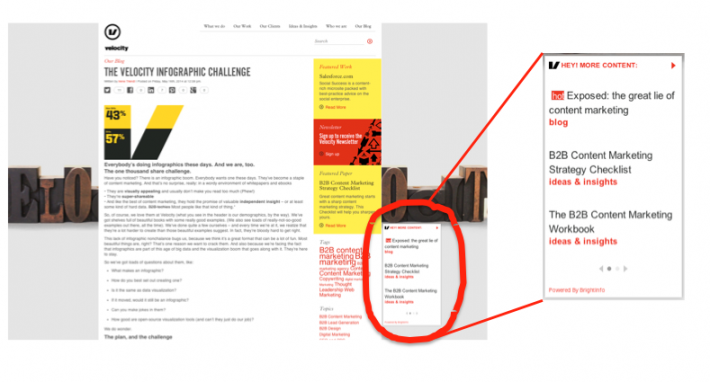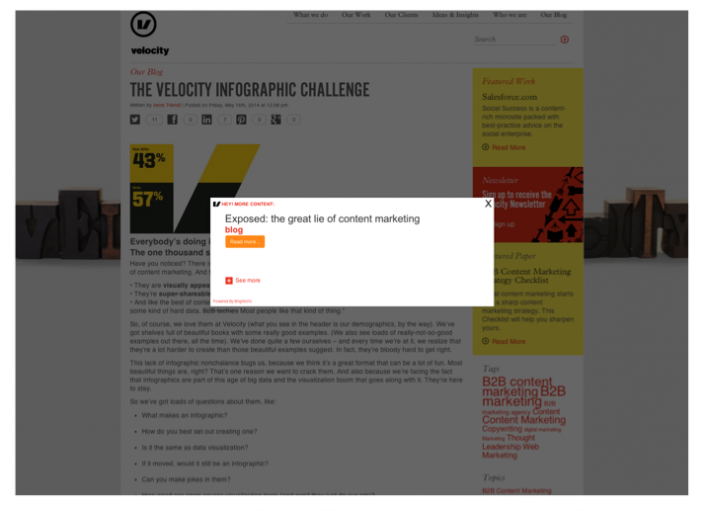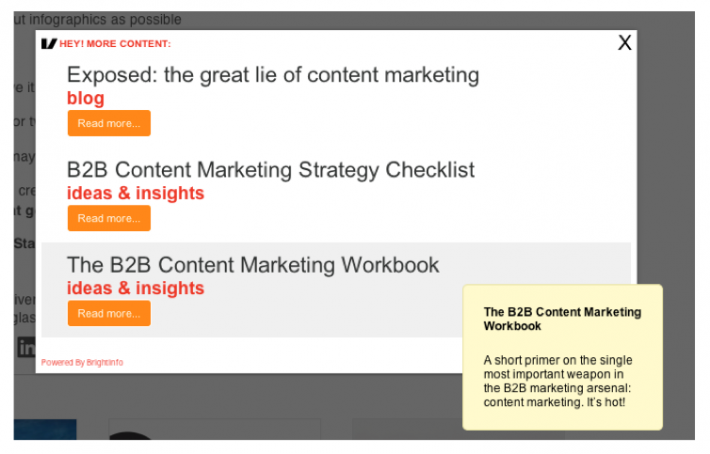You know those pop-ups that, well, pop up and make you an offer when you’re about to leave a website?
Well they always bothered me. They feel kind of desperate or crassly self-serving, like the McDonald’s order-takers who ask if you want fries with that.
But two things kept me from railing against them:
1) I do sometimes ‘engage’ with them.
Sometimes, the offer they make is appealing enough that I click. So the marketer in me (also known as ‘me’) files that away under ‘stuff that just might work for our clients’.
2) A HUGE proportion of web visitors come to us once, don’t leave a name, and never come back.
And the data I’ve seen suggests this is typical. To which I can only say, “OUCH! Ouch-ouch-ouch-ouch-ouch-OUCH.”. All that time, money and effort to get people to your site and they wander off FOREVER? Without so much as an email address or a box of chocolates? The marketer in me (me again) thinks about this and cries bitter, blood-tinged tears.
So we figured we’d give this pop-up or ‘exit-triggered promo’ thing a try – just to see how well it works.
We (actually Daniel Smulevich, one of our clever analysts who has since left Velocity for a better-paying but ultimately soul-destroying job, crack addiction, homelessness and multiple cat ownership) chose to work with BrightInfo for our experiment. (If you want to see how these things work, go to their site and try to leave).
This is what they say of themselves:
“BrightInfo discovers anonymous visitor’s intent in real-time and dynamically offers your most relevant content – from white-papers to videos to case studies.”
And that’s why we chose them for our experiment. Because if we were going to risk annoying our visitors, we wanted to do it intelligently (which, we hope, means annoying fewer people and annoying them less).
It’s like ad remarketing (which we also hated but tried and now hate significantly less): if it’s done intelligently, it’s less intrusive, more helpful and lot less annoying.
In short, we didn’t want to do stupid things in public: like using static content promos that push the wrong content at the wrong people or shove a piece at someone who’s already read it.
So could we make pop-up “Don’t Go Yet!” appeals less annoying?
And if so, would they actually work?
That’s what we set out to discover.
How it works.
The BrightInfo processor crawled our website, using a mix of methods to identify Key Terms for each page (mostly phrases rather than single words). Geeks might like to know that they use a combination of Natural Language Processing (or ‘magic’), complex regular expressions (say what?) and HTML analysis (sounds clever). Then, to validate the key terms, BrightInfo applies statistical analysis and identifies synonym relations between terms.
After the analysis, BrightInfo automatically matches the promoted content to each web page based on their scoring mechanism.
Then, in real-time, the tool decides what to show to the visitor based on the information extracted by the site processor, the visitor profile and behaviour (entry page, navigation on site, history, time on each page, etc) and statistical/behavioural analysis.
Crucially, the pop-up can be suppressed for low-engaging visitors, so you’re only hitting people who have shown some level of involvement (three blog posts read for instance).
The idea is simple: if you’re going to ask, “Do you want fries with that?” to a prospect on the way out the door, make sure they like fries, haven’t already ordered them and aren’t potato-phobic.
Here’s what it looked like on our site.
When we did the experiment, BrightInfo didn’t let you really design the lightboxes and panels – just specify colour and choose from a limited font menu. They’ve changed that (I think our constant whining may have played a part) and now you can pretty them up a lot more and make them fit your website.
There are two kinds of panel: a sidebar that’s always there on every page you don’t exclude; and an ‘exit widget’ that can be configured to pop up in the centre of any page you choose when the visitor shows signs that they’re about to leave (a quick mouse move to the top of the page is a biggie). According to BrightInfo, it’s not uncommon for people to click five times more on the Exit Widget than the sidebar — but the overall performance is 30-40% of the sidebar because the latter is displayed far more often .
This is a typical sidebar:
It’s tucked in some open space, outside the frame of our page, so it doesn’t overlay any of our content. As you can see, it competes with our own content suggestions – the yellow bar on the right – and tag-driven ‘Related Posts’ beneath every post (out of view in the screen grab above). But those are static — no targeting or intelligence.
Note: this is NOT a pop-up, it’s an always-on panel that, ideally, feels like a natural part of your site. So even if the pop-op makes you nervous, you can go with just the sidebar.
This is the Exit Widget offering one piece of content:
Just before you exit, the whole page goes dark and a single piece of (usually high-value) content is suggested. The one shown is not pretty but BrightInfo has changed that so you can brand it better.
You can apply this pop-up to a single page of your site or every page — or just turn it off. So if the idea of interruption bothers you, just don’t use it.
This is the multi-content Exit Widget:
Offering three pieces with roll-over extracts. The Software will rotate pieces through the lightbox and change lightbox styles to find out what works for each page.
What happened when we gave it a go
The tool was active on our website from 10th April to 21st May, 2014 but the data shown below are for the period 14/4 – 18/5 inclusive, to show five full weeks.
The Topline:
Compared to the previous five weeks, Google Analytics showed that our bounce rate decreased by 7.27% and exit rate by 4.44% . For our site, this isn’t life-changing but for a high-volume site it is more than significant.
Some drill-down:
| Most Popular Items Clicked In BrightBox | ||||||||||||||||||||||||||||||
|
The above chart shows the uplift that the BrightInfo sidebar gave us for the top five content pieces promoted. The “number of native visits” column counts only the visits to this content from other pages within our site, excluding visits direct from search engines, so we’re comparing how our site performs with and without the widget.
As you can see, BrightInfo did get people to view content they wouldn’t have viewed otherwise. And that’s the whole point.
The percentage increase is a bit misleading as the numbers are small but just on raw views, this looks worth doing — especially considering that these people were on their way out the door.
Upside
- The experiment delivered positive results and let us tailor content recommendations to users (rather than simply to an article or page).
- The longer you leave it on, the better it works – making better recos based on performance (without having to touch it).
- There’s potential to use ‘virtual gating’, (which we didn’t try), so you can capture an email even for content that’s ungated on your site.
- The analytics are good – and getting better.
- You can assign relative importance to certain pages and sets of pages – and exclude pages you don’t want to show the widgets on.
- The Brightinfo team were super-responsive and helpful. Gotta be said.
Downside
- Integration with Google Analytics is done through utm parameters: We disabled this to prevent referral cannibalization (hate that). Brightinfo promptly disabled that feature upon request. This means we had to use Brightinfo’s analytics only. We’d recommend the use of Google Analytics events.
- Some site integration glitches – Because of our custom theme, the widget didn’t automatically show up on the website’s homepage and the blog’s “homepage” – in the first case, that is actually not bad but it would be good to have the option.
- Weird content choices – Sometimes we felt the tool was inexplicably skewed towards certain blog posts.
- Inability to specify content recos on a per-page basis – Apparently now being rolled out, along with other over-ride features.
- You never know how many people you pissed off for every one you converted – this is the unmeasurable downside.
Conclusion
I went in as a skeptic. I never liked these things. But my lurking reservations about that antipathy proved true: they work. And if they’re done intelligently, as I believe the BrightInfo guys are doing, you can push the upside and mitigate the annoyance factor.
In fact, the sidebar deployment isn’t annoying or intrusive at all (though it may compete with other feature boxes on your site).
Would I recommend it to clients? In many cases, yes, I would. Letting anonymous visitors snivel away without at least pitching something relevant to them seems too big a waste.
I might not recommend some of the other pop-up tools I’ve seen — the static versions with no personalisation, or even the rule-based ones (rules get really unwieldy really fast with something like this). But I do like what BrightInfo is doing and I think it’s worth serious consideration.
So why isn’t Velocity using it any more?
We thought you might mention the elephant in the room.
We’re not using it because the upside just isn’t big enough at our traffic levels to justify the gut-feel downside of annoying the proto-friends who come to our precious website. We also have an ethos about not trying too hard to ‘convert’ our visitors, preferring to engage on their terms, but this reflects our specific situation and is maybe the subject of a later blog post.
Yes, it’s a great way to keep long-tail content exposed. Yes it works. And if you’re worried about pop-ups becoming annoying, you can dial them back or turn them off (without losing the sidebar benefits).
If you’re as appalled as I am about the number of people who drift in and out of your website without ever saying hello, you may want to test drive BrightInfo. It’s ridiculously easy to deploy and is the most intelligent way to approach this tactic.

Enjoyed this article?
Take part in the discussion











Comments
Jeanne Hopkins July 31st, 2014
Congratulations for doing a test. And, yes, BrightInfo might not be for everyone. No single marketing tool ever meets the needs of every user But, for those companies that need leads for their sales team and to grow their businesses, BrightInfo might make sense. As a demand gen marketer, not an arts & crafts marketer like you, we depend upon leads to feed our sales team members. That is how we are measured – by creating lead flow, by converting visitors to leads, and the revenue that is attained from those leads.”
Alessio August 1st, 2014
Interesting.
I went to BrightInfo website and a pop up well popped up (cit) and it was this one:
http://imgur.com/RxCvC0p
now. I get the power of pop ups and engaging with our visitors, but I’d never click on something like that.
The style is just lame and the copy…oh wait, what copy? Why am I in the homepage and you recommend this video? and moreover, what is this video about? Bounce prevention 101…what does this mean? You are recommending a video and the “call to action” is “read more”?
“see more” of what? other videos? other bounce prevention stuff?
I closed the website and buggered off.
Doug Kessler August 4th, 2014
Thanks for the report, Alessio.
One of the problems with these kinds of things is that no one captures the invisible downside: the annoyance factor.
Google Analytics can only capture what someone did, not what someone felt!
Boaz August 4th, 2014
Doug thanks for taking the time to review BrightInfo and for the kind words.
We built BrightInfo to help small to medium businesses grow their business without investing the personnel and efforts required from high end online marketing solutions. Like any automated solution I’m sure BrightInfo misses every now and than but we know it is providing a positive impact for many businesses around the globe based on hard measured results like $ and business leads.
Doug to your point there is also an invisible upside in delivering a personal experience with personal content offers, even if automated. I would argue it cancels out the downside (Again, measurable results from many businesses worldwide) and ads some positive upside. You don’t really believe the future of the web is static content and we are one of the first firms to make an effort at delivering a personal experience for online visitors.
Alessio – Passing judgement based on one experience/data-point seems questionable to me…I would expect you to take the time to browse our site, see the dynamic/personal recommendations and experience the full capabilities of the product to make an educated commentary.
Alessio August 5th, 2014
Hey Boaz,
yes, I would have browse your site, but as soon as I landed I was annoyed by that pop up, and the pop up itself was not even interesting to me.
So I’m just a user , and as such, I am in charge of what I felt when I landed in your website. Or you just assume that people need to browse the website as you wish because you are in love with it ?
And yes, sometimes one experience is enough to lose a customer / reader.
Eran Livneh August 5th, 2014
In my book there are two criteria for a good marketing tool: it’s measurable and easy to operate. BrightInfo nicely fit these criteria. Yes, some visitors may be annoyed, but it can be measured by the bounce rate on the site. You can even A/B test it with and without the widget. If your goal is to capture leads, try it (that’s where the ease of deployment becomes important) and see how it performs. If you are concerned about losing visitors, measure it. Then figure out the benefits vs. the downside and make an educated decision that is based on data rather than “fear of annoying.”
David August 5th, 2014
Hi,
I saw this article, Doug it was very interesting and clearly well researched.
Our company saw some great results with BrightInfo and it has really helped us expose more content to site visitors and ultimately led to those people signing up, when they might have otherwise left the site after their first page visit.
In a field where you want to expose as much quality content as possible and keep the UI clean BrightInfo accomplishes that pretty well.
To the annoying issue, I don’t think everyone can be satisfied all time with different marketing efforts. I have been doing Marketing for many years, and there are tactics that are used that I personally find annoying, but I still use them in my Marketing strategy because they work for the masses. So this really becomes a conversation of what works to the majority of your target audience to help accomplish your company goals.
Thanks for the good read Doug.
Debbie August 5th, 2014
Hi, as a marketer I too am always looking for additional tools to avoid the “OUCH! Ouch-ouch-ouch-ouch-ouch-OUCH” as was so clearly described by Doug, so I decided to try out BrightInfo.
I saw a drop in bounce rates and the number of conversions from our website increased. Yes, I agree that it might annoy some visitors, but it was clear to see that the advantages far outweighed the disadvantages. Sales reps need leads and marketing has the responsibility to supply them. I guess I will never know if I annoyed a few visitors, but I feel that BrightInfo is a success if I have managed to increase our website conversion rate and bring new relevant contacts for our sales team, as let’s face it, we are here to sell and we can’t sell to someone we don’t know.
Doug Kessler August 5th, 2014
All good comments — thanks.
@Jeanne – We too depend on leads to feed our business. That is our art and craft. But that doesn’t mean leads at ALL costs.
@Boaz – I think the upside you describe is not invisible at all, it’s very measurable, and clearly your software does drive this improvement.
The potential annoyance downside feels much harder to measure: it’s in the mind of the visitor and only results in an absence of behaviour.
@Alessio – I wouldn’t expect any tool to get it right 100% of the time. If the annoyance was great enough to totally alienate you, I’m glad you’re honest enough to say so. I don’t think many people will feel quite as strongly (especially among the marketing target audience) but some will.
@Eran Wouldn’t the downside be hard to measure using bounce rates? These visitors are by definition, bouncing anyway. (Which is one of the things I like about BrightInfo).
@David – I agree: you can’t please everyone. I just think one should go into any decision with open eyes. In truth, I think the upside outweighs the downside for most sites.
@Debbie – your experience must trump my experiment. If it works, keep using it. I would too!
All: I hope I haven’t over-played the annoyance factor. I can’t speak for anyone else but I know I have felt annoyed at some crass examples of pop-ups. Still, what annoys does change over time. Talking on a mobile phone on a train used to be the height of crassness. Now everyone does it (and some do it rudely).
I really hope this doesn’t come off as a negative review. As I said in the conclusion, I will recommend this tool. But I do feel marketers need to keep an eye on the annoyance factor and decide for themselves where the balance lies.
Thanks again.
Alessio August 5th, 2014
@All: don’t get me wrong. I spoke as random visitor who is seeing that “pop up”.
As marketer: test, test, test…if it’s working, all the better and congrats to Brightinfo.
I think I needed to separate between me user and me marketer 🙂
One thing I learnt from my experience as marketer: what people say is not working works for my website and my audience. That’s why testing is the most important thing many marketers are not considering.
Love you all.